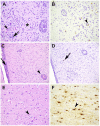Zoonotic Mutation of Highly Pathogenic Avian Influenza H5N1 Virus Identified in the Brain of Multiple Wild Carnivore Species
- PMID: 36839440
- PMCID: PMC9961074
- DOI: 10.3390/pathogens12020168
Zoonotic Mutation of Highly Pathogenic Avian Influenza H5N1 Virus Identified in the Brain of Multiple Wild Carnivore Species
Abstract
Wild carnivore species infected with highly pathogenic avian influenza (HPAI) virus subtype H5N1 during the 2021-2022 outbreak in the Netherlands included red fox (Vulpes vulpes), polecat (Mustela putorius), otter (Lutra lutra), and badger (Meles meles). Most of the animals were submitted for testing because they showed neurological signs. In this study, the HPAI H5N1 virus was detected by PCR and/or immunohistochemistry in 11 animals and was primarily present in brain tissue, often associated with a (meningo) encephalitis in the cerebrum. In contrast, the virus was rarely detected in the respiratory tract and intestinal tract and associated lesions were minimal. Full genome sequencing followed by phylogenetic analysis demonstrated that these carnivore viruses were related to viruses detected in wild birds in the Netherlands. The carnivore viruses themselves were not closely related, and the infected carnivores did not cluster geographically, suggesting that they were infected separately. The mutation PB2-E627K was identified in most carnivore virus genomes, providing evidence for mammalian adaptation. This study showed that brain samples should be included in wild life surveillance programs for the reliable detection of the HPAI H5N1 virus in mammals. Surveillance of the wild carnivore population and notification to the Veterinary Authority are important from a one-heath perspective, and instrumental to pandemic preparedness.
Keywords: HPAI H5N1 influenza; brain; carnivores; full genome sequences; immunohistochemistry; pathology; phylogenetic analysis; virology; wildlife; zoonotic mutation.
Conflict of interest statement
The authors declare no conflict of interest.
Figures



References
-
- Alkie T.N., Lopes S., Hisanaga T., Xu W., Suderman M., Koziuk J., Fisher M., Redford T., Lung O., Joseph T., et al. A threat from both sides: Multiple introductions of genetically distinct H5 HPAI viruses into Canada via both East Asia-Australasia/Pacific and Atlantic flyways. Virus Evol. 2022;8:veac077. doi: 10.1093/ve/veac077. - DOI - PMC - PubMed
-
- Caliendo V., Lewis N.S., Pohlmann A., Baillie S.R., Banyard A.C., Beer M., Brown I.H., Fouchier R.A.M., Hansen R.D.E., Lameris T.K., et al. Transatlantic spread of highly pathogenic avian influenza H5N1 by wild birds from Europe to North America in 2021. Sci. Rep. 2022;12:11729. doi: 10.1038/s41598-022-13447-z. - DOI - PMC - PubMed
-
- European Food Safety Authority. European Centre for Disease Prevention and Control. European Union Reference Laboratory for Avian Influenza. Adlhoch C., Fusaro A., Gonzales J.L., Kuiken T., Marangon S., Niqueux É., Staubach C., et al. Avian influenza overview June–September 2022. EFSA J. 2022;20:e07597. doi: 10.2903/j.efsa.2022.7597. - DOI - PMC - PubMed
-
- Postel A., King J., Kaiser F.K., Kennedy J., Lombardo M.S., Reineking W., de le Roi M., Harder T., Pohlmann A., Gerlach T., et al. Infections with highly pathogenic avian influenza A virus (HPAIV) H5N8 in harbor seals at the German North Sea coast, 2021. Emerg. Microbes Infect. 2022;11:725–729. doi: 10.1080/22221751.2022.2043726. - DOI - PMC - PubMed
-
- Floyd T., Banyard A.C., Lean F.Z.X., Byrne A.M.P., Fullick E., Whittard E., Mollett B.C., Bexton S., Swinson V., Macrelli M., et al. Encephalitis and Death in Wild Mammals at a Rehabilitation Center after Infection with Highly Pathogenic Avian Influenza A(H5N8) Virus, United Kingdom. Emerg. Infect. Dis. 2021;27:2856–2863. doi: 10.3201/eid2711.211225. - DOI - PMC - PubMed
Grants and funding
LinkOut - more resources
Full Text Sources

